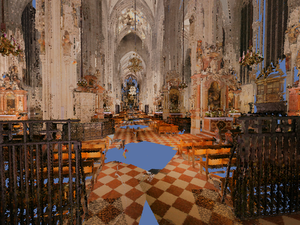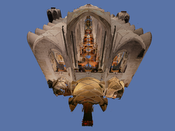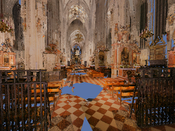Information
- Publication Type: Master Thesis
- Workgroup(s)/Project(s):
- Date: 2006
- TU Wien Library:
- First Supervisor: Michael Wimmer
- Keywords: out-of-core rendering, point-based rendering, datastructure
Abstract
In this diploma thesis a fast rendering algorithm for very large point clouds is described. A point cloud is simply a set of unconnected 3D coordinates in cartesian space. Each coordinate of such a set is interpreted as a point in space. A point cloud is the result of a sampling process, where either a laser scanner samples a real environment, or the data structure of some already existing graphical model is point sampled. During rendering it is attempted to reconstruct the sampled model from the given point cloud. The algorithm presented in this thesis builds on two new data structures, namely Memory Optimized Sequential Point Trees and Nested Octrees. It includes an out-of-core part, which means that it is also possible to render models that do not fit in the main memory of the computer, and an occlusion-culling part, which means that objects, which are hidden by objects closer to the viewer, do not have to be rendered. The algorithm is developed primarily for the fast rendering of point clouds, i.e., with a high frame rate, whereas the visual quality of the rendered point clouds is not in the focus of this work. The algorithm does not need any additional attributes at a point besides the position.Additional Files and Images
Weblinks
No further information available.BibTeX
@mastersthesis{Scheiblauer-2006-DA,
title = "Hardware-Accelerated Rendering of Unprocessed Point Clouds",
author = "Claus Scheiblauer",
year = "2006",
abstract = "In this diploma thesis a fast rendering algorithm for very
large point clouds is described. A point cloud is simply a
set of unconnected 3D coordinates in cartesian space. Each
coordinate of such a set is interpreted as a point in space.
A point cloud is the result of a sampling process, where
either a laser scanner samples a real environment, or the
data structure of some already existing graphical model is
point sampled. During rendering it is attempted to
reconstruct the sampled model from the given point cloud.
The algorithm presented in this thesis builds on two new
data structures, namely Memory Optimized Sequential Point
Trees and Nested Octrees. It includes an out-of-core part,
which means that it is also possible to render models that
do not fit in the main memory of the computer, and an
occlusion-culling part, which means that objects, which are
hidden by objects closer to the viewer, do not have to be
rendered. The algorithm is developed primarily for the fast
rendering of point clouds, i.e., with a high frame rate,
whereas the visual quality of the rendered point clouds is
not in the focus of this work. The algorithm does not need
any additional attributes at a point besides the position.",
address = "Favoritenstrasse 9-11/E193-02, A-1040 Vienna, Austria",
school = "Institute of Computer Graphics and Algorithms, Vienna
University of Technology ",
keywords = "out-of-core rendering, point-based rendering, datastructure",
URL = "https://www.cg.tuwien.ac.at/research/publications/2006/Scheiblauer-2006-DA/",
}

 thesis
thesis


